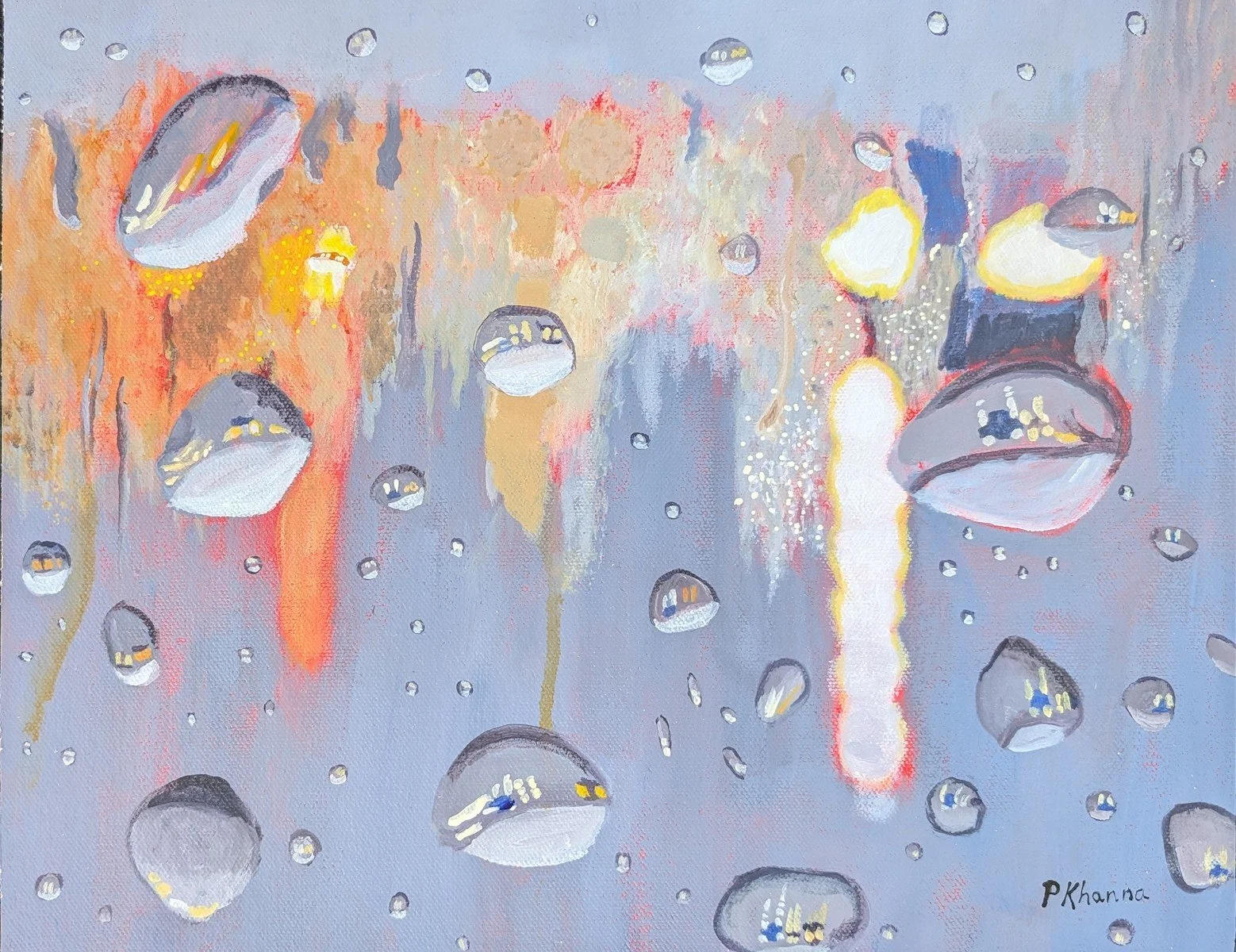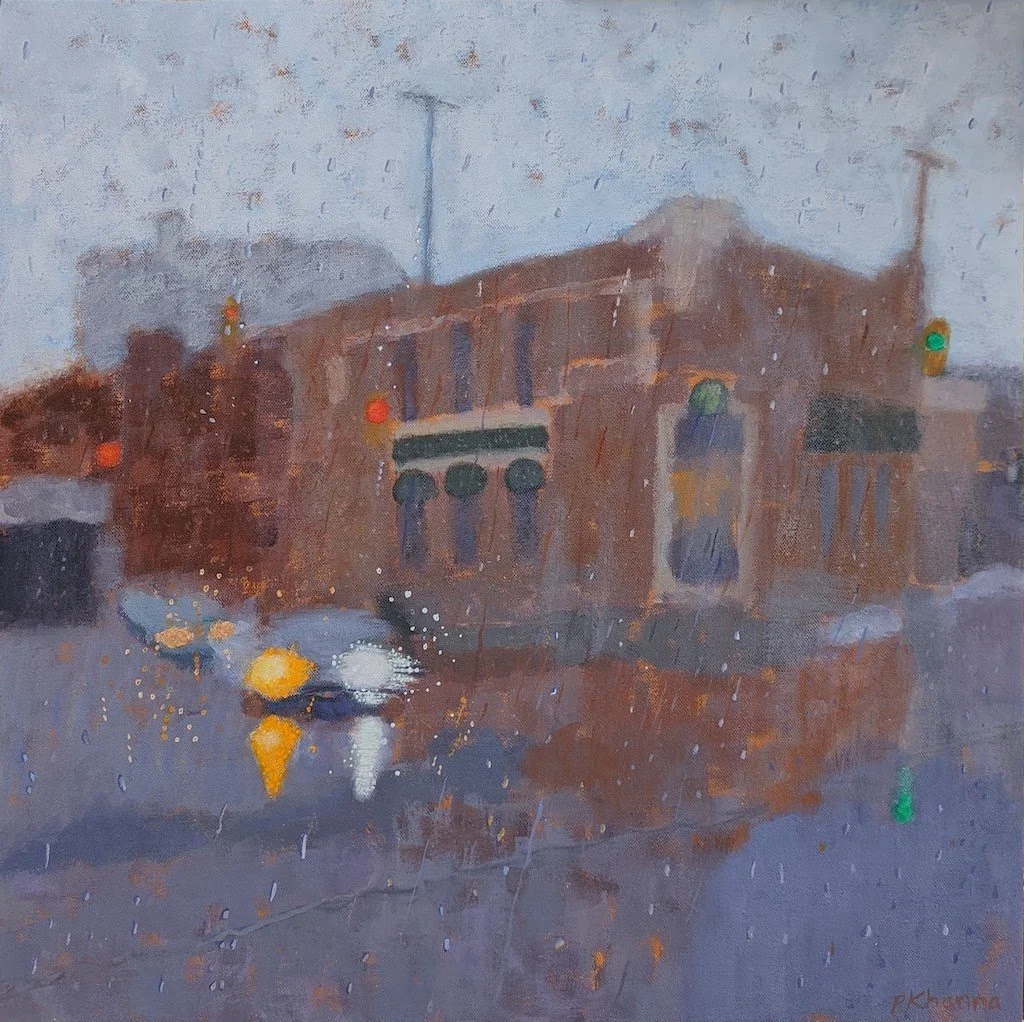Through the Rain-Blurred Glass: A Conversation with Poonam Khanna
Poonam Khanna is an award-winning, emerging Toronto-based artist working primarily in acrylics. She discovered her love of painting nine years ago at a paint night event she attended. Since then, she has been passionate about her pursuit of painting, making it an almost daily practice.
Poonam began exhibiting her work in 2021 and has appeared in more than fifty group shows, including the Riverdale ArtWalk, the Square Foot Show, and the Toronto Outdoor Art Fair. She was juried into the Federation of Canadian Artists as an elected member in 2023 and had her first solo show in that same year. In 2024, Poonam was named the 2nd Runner-Up in the Arts to Hearts Emerging Woman Artist of the Year Fall Artprize. She also received an Honourable Mention for her painting Out for Delivery 2 in the Federation of Canadian Artists’ Scenes from Canada 2025 exhibit.
poonamkhanna.ca
You can explore and purchase Poonam Khanna’s works on our sister platform: PXP Contemporary – Poonam Khanna Collection
Your work captures the beauty and ambiguity of rain through glass. What first drew you to this subject, and what keeps it creatively alive for you?
I happened upon my subject matter—rainscapes through glass—by happenstance. I was on my way to work, and it was pouring rain, so instead of walking to the subway, as I normally do, I waited for the bus in the bus shelter. While waiting, I snapped a few shots through the glass and didn’t think much of it at the time. Afterwards, I looked at the shots I took, and they were stunning—they were abstracted and full of lights shining on the pavement and in the raindrops. The grey rainy day had been transformed, and so had my neighbourhood.
At the time, I was taking an Introduction to Painting class, and even though painting the scenes from those images was way beyond my skill level, I knew I had to try. And a friend, who himself is an artist, bought my first-ever rainscape, which was thrilling.
What keeps me coming back to that subject is how many ways a watery lens can change a landscape. It can soften edges, blend objects into one another, fill the landscape with glowing light, sparkle, obscure, and reflect what’s behind the glass. The raindrops can contain their own mini, distorted landscape. It’s a cohesive series, but with a lot of scope.
The series offers me glimpses into moments in the life of my city (Toronto), and the people who live here as they hurry on their way.
I’ve painted more than 200 rainscapes now, and I know I haven’t even come close to exploring the subject fully.
You’ve described rain as something that blurs, distorts, and reframes what we see. How do you translate that fluidity and transformation into your painting technique?
This can be challenging. It’s much easier to paint an object or person if you can see all of its edges—if everything is clearly delineated. But when it’s difficult to see where one object begins and another ends, it becomes more challenging. I try to paint the shapes, I spend a lot of time softening edges, which is challenging with acrylics. I also simplify the landscape behind the glass, as the raindrops add a lot of detail.
Sometimes, I take a looser approach, and I let watery paint drip down. I also start with a bold red, and let it shine through—one more random shape in a painting full of random shapes.
Can you tell us about your “portable window” and how it’s become part of your process?
As I took my first rainy day shots from the sidewalk, I wanted to continue getting shots from that perspective, and not just through car windshields. Being on the sidewalk gets me closer to pedestrians and cyclists. I found myself walking in my neighbourhood looking for bus shelters that I could take pictures from, and soon I knew where they all were. I wished I could stand on a particular corner because it was busy, or had beautiful old buildings, or was tree-lined. Finally, I decided I needed to DIY the glass. So I bought a frame, got rid of the backing, and taped up the edges with duct tape to secure the glass to the frame. Now, I plan which neighbourhood I’m going to head to when it rains. And my “portable window” transforms the landscape.
Color plays a powerful role in your work—especially in contrast to the softness and grey tones of rainy scenes. How do you approach color in your compositions?
Colour becomes surprisingly powerful in my rainscapes. The city itself often fades into shades of grey, but against this muted background, bright pops of colour really stand out. The warm reflection of streetlights and car headlights on the pavement, the glow of neon signs or the pops of colours of umbrellas or a bright item of clothing really stand out. These bursts of colour cut through the gloom and our eyes head right to them. They become the focus of the scene, rendering it beautiful.
To ensure these colours are harmonious with the painting, I usually add in a touch of the grey to it, and use a limited colour palette.
You began painting just nine years ago at a paint night and now exhibit across Canada and beyond. What has that journey taught you about growth, discipline, and creative passion?
One of the biggest challenges I had when I first started painting was giving up when something wasn’t going right—there were many abandoned paintings. Each painting goes through an ugly phase, but to a novice painter, these ugly phases feel like definitive failures. And I’d abandon painting after painting, hoping to do better in the next one.
But painting involves a lot of problem solving—you have to work through problem areas. And doing this helps you vastly improve your skills.
I eventually learned the value of pushing through these difficult phases. Now if there’s a problem area, I sit down to “work it.” It’s in taking on these challenges, making adjustments, and layering new decisions over old ones, that paintings transform beyond these problematic phases. This helped me grow, along with carving out the time and space to paint regularly.
You’ve participated in more than fifty exhibitions in just a few years. How has this momentum impacted your confidence, direction, or sense of community as an artist?
Although I’ve taken many painting classes and workshops over the years, I never had any formal training, so I often felt like an imposter, and never more so than when I started getting into shows. The first time I got into a show, I didn’t tell anyone except my husband. I wanted to give them a few days to tell me they’d accidentally sent me the wrong email. But that email never came.
Then when I got into yet more shows, I began questioning the value of the shows—it was a, “I wouldn’t want to belong to a club that would have someone like me as a member,” moment. But looking at some of the art I was hanging beside—I knew that this was wrong.
It’s so hard to be objective about your own work. Nowadays, I often ask myself, if I saw this piece hanging in a show, and it wasn’t mine, would I like it? Would I want to take it home? And if I’m honest with myself now, the answer is often, “Yes.”
I know that becoming a painter is a matter of persistence, and not just something innate. So, if it can be true of others, why can’t it be true of me?
Eventually, you do begin building up your confidence, and begin believing in yourself.
Being in so many shows is also a great way to meet many other artists. I know they share some of the same challenges, self-doubts and struggles, and knowing that I’m not alone is a great help.
What do you hope viewers feel or reflect on when they see one of your rain-soaked cityscapes?
I hope they look at scenes they’ve seen many times in a new way and see the beauty in what most of us think of as a dreary day to be gotten through. If you stop and take a moment to look, it can be beautiful, and the pedestrians and cyclists who are undeterred by the rain are an inspiration.
I also hope they feel a sense of warmth and coziness, as they are viewing the scene from behind the glass, and are not caught in the storm. From this comfortable setting, they are viewing a world both familiar and transformed, a world that has been both greyed out and filled with light.








